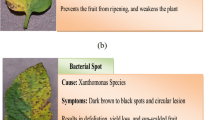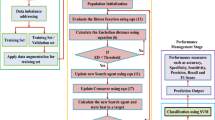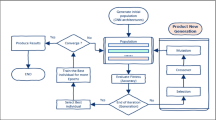Abstract
For the diagnosis and identification of invasive pests and diseases at an earlier stage in tomato plants, an effective plant disease diagnosis system should be developed. Therefore, this article proposes an automatic tomato leaf disease identification system using a pre-trained convolutional neural network (CNN) architecture powered by crossover-based wind-driven optimization (CROWDO) algorithm. This method helps to improve the classification accuracy of tomato leaf disease when compared to the existing supervised machine learning algorithms. Here, the CROWDO approach is used to improve the accuracy of the pre-trained AlexNet architecture to reduce overfitting, training time, and excessive energy consumption. The proposed model is capable of identifying four tomato leaf diseases (Leaf Mold, Early Blight, Target Spot, and tomato Yellow Leaf Curl) and the leaf damage caused by two-spotted spider mites. The experimental analysis has been performed, and the results demonstrated that the CROWDO-optimized AlexNet architecture for tomato leaf disease classification outperforms various pre-trained such as VGG16, GoogleNet, SqueezeNet, and LeNet by the accuracy of 99.86%. The time taken for training our proposed CROWDO-optimized AlexNet architecture was 12.3654 s which is relatively less than the time taken by other pre-trained architectures such as LeNet, VGGNet, SqueezeNet, and GoogleNet in terms of seconds. The proposed CROWDO-optimized AlexNet architecture not only improves classification accuracy but also assisted the farmers in identifying the area of disease and pest infestation in real-time, as well as meeting real-time detection accuracy standards.










Similar content being viewed by others
Data availability
Data sharing is not applicable to this article as no new data were created or analyzed in this study.
References
Ahmad I, Hamid M, Yousaf S, Shah ST, Ahmad MO (2020) Optimizing pretrained convolutional neural networks for tomato leaf disease detection. Complexity
Annabel LSP, Muthulakshmi V (2019) AI-powered image-based tomato leaf disease detection. In 2019 Third international conference on I-SMAC (IoT in Social, Mobile, Analytics and Cloud) (I-SMAC) (pp. 506–511). IEEE
Asit KM, Praveen KM, Subrata D, Arup C (2017) Effective management of major tomato diseases in the gangetic plains of Eastern India through integrated approach. Agric Res Technol 10:555796
Barbedo JGA (2013) Digital image processing techniques for detecting, quantifying and classifying plant diseases. Springerplus 2(1):660
Basavaiah J, Anthony AA (2020) Tomato leaf disease classification using multiple feature extraction techniques. Wirel Pers Commun, pp. 1–19.
Basu PK (1974) Measuring early blight, its progress and influence on fruit losses in nine tomato cultivars. Can Plant Dis Surv 54(2):45–51
Chaitanya GK, Maragatham G (2021) Object and obstacle detection for self-driving cars using GoogLeNet and deep learning. In: Artificial intelligence techniques for advanced computing applications, pp. 315–322. Springer, Singapore
Darwish A, Ezzat D, Hassanien AE (2020) An optimized model based on convolutional neural networks and orthogonal learning particle swarm optimization algorithm for plant diseases diagnosis. Swarm Evolut Comput 52:100616
Datar VV, Mayee CD (1981) Assessment of losses in tomato yield due to early blight
Deng J, Dong W, Socher R, Li LJ, Li K, Fei-Fei L (2009) Imagenet: A large-scale hierarchical image database. In: 2009 IEEE conference on computer vision and pattern recognition (pp. 248–255). IEEE
Dubey A (2020) Agricultural plant disease detection and identification. Int J Electr Eng Technol 11(3)
Elsaadouny M, Barowski J, Rolfes I (2020) Extracting the features of the shallowly buried objects using LeNet convolutional network. In 2020 14th European conference on antennas and propagation (EuCAP) (pp. 1–4). IEEE.
Fang Z, Ren J, Marshall S, Zhao H, Wang S, Li X (2020) Topological optimization of the DenseNet with pretrained-weights inheritance and genetic channel selection. Pattern Recogn 109:107608
FAO (2020) Fruit and vegetables – your dietary essentials. The international year of fruits and vegetables, 2021, background paper. Rome. https://doi.org/10.4060/cb2395en
Ferentinos KP (2018) Deep learning models for plant disease detection and diagnosis. Comput Electron Agric 145:311–318
Gadekallu TR, Rajput DS, Reddy MPK, Lakshmanna K, Bhattacharya S, Singh S, Alazab M (2020) A novel PCA–whale optimization-based deep neural network model for classification of tomato plant diseases using GPU. J Real-Time Image Process pp. 1–14.
Green SK (1994) Leaf curl and yellowing viruses of peper and tomato an overview (No. 0935 caja (92)). Asian Vegetable Research & Development Center
Hanssen IM, Lapidot M, Thomma BP (2010) Emerging viral diseases of tomato crops. Mol Plant Microbe Interact 23(5):539–548
Hari V, Madheswari AN (2013) Improving security in digital images through watermarking using enhanced histogram modification. In: Advances in Computing and Information Technology. Springer, Berlin, Heidelberg. p 175–180
Hassan MM, Gumaei A, Alsanad A, Alrubaian M, Fortino G (2020) A hybrid deep learning model for efficient intrusion detection in big data environment. Inf Sci 513:386–396
Hughes D, Salathé M (2015) An open access repository of images on plant health to enable the development of mobile disease diagnostics. arXiv preprint arXiv:1511.08060
Iandola FN, Han S, Moskewicz MW, Ashraf K, Dally WJ, Keutzer K (2016) SqueezeNet: AlexNet-level accuracy with 50× fewer parameters and < 0.5 MB model size. arXiv preprint arXiv:1602.07360
Jose J, Gautam N, Tiwari M, Tiwari T, Suresh A, Sundararaj V, Rejeesh MR (2021) An image quality enhancement scheme employing adolescent identity search algorithm in the NSST domain for multimodal medical image fusion. Biomed Signal Process Control 66:102480
Karthik R, Hariharan M, Anand S, Mathikshara P, Johnson A, Menaka R (2020) Attention embedded residual CNN for disease detection in tomato leaves. Appl Soft Comput 86:105933
Khan S, Narvekar M (2020) Disorder detection of tomato plant (solanum lycopersicum) using IoT and machine learning. J Phys Conf Ser 1432(1):012086
Khan A, Nawaz U, Ulhaq A, Robinson RW (2020) Real-time plant health assessment via implementing cloud-based scalable transfer learning on AWS DeepLens. PLoS ONE 15(12):0243243
Liu J, Wang X (2020) Early recognition of tomato gray leaf spot disease based on MobileNetv2-YOLOv3 model. Plant Methods 16(1):1–16
Lu J, Ehsani R, Shi Y, de Castro AI, Wang S (2018) Detection of multi-tomato leaf diseases (late blight, target, and bacterial spots) in different stages by using a spectral-based sensor. Sci Rep 8(1):1–11
Mehra T, Kumar V, Gupta P (2016) Maturity and disease detection in tomato using computer vision. In: 2016 Fourth international conference on parallel, distributed and grid computing (PDGC) (pp. 399–403). IEEE
Mokhtar U, Ali MA, Hassenian AE, Hefny H (2015) Tomato leaves diseases detection approach based on support vector machines. In 2015 11th International computer engineering conference (ICENCO) (pp. 246–250). IEEE
Natarajan VA, Babitha MM, Kumar MS (2020) Detection of disease in tomato plant using deep learning techniques. Int J Mod Agric 9(4):525–540
Owomugisha G, Quinn JA, Mwebaze E, Lwasa J (2014) Automated vision-based diagnosis of banana bacterial wilt disease and black sigatoka disease. In: International conference on the use of mobile ICT in Africa (pp. 1–5)
Rejeesh MR (2019) Interest point based face recognition using adaptive neuro fuzzy inference system. Multimed Tools Appl 78(16):22691–22710
Rothe PR, Kshirsagar RV (2015) Cotton leaf disease identification using pattern recognition techniques. In: 2015 International conference on pervasive computing (ICPC) (pp. 1–6). IEEE
Rubanga DP, Loyani LK, Richard M, Shimada S (2020) A deep learning approach for determining effects of tuta absoluta in tomato plants. arXiv preprint arXiv:2004.04023
Sadashiva AT, Singh A, Kumar RP, Sowmya V, D’mello DP (2016) Tomato. In: Abiotic stress physiology of horticultural crops (pp. 121–131). Springer, New Delhi
Salih TA (2020) Deep learning convolution neural network to detect and classify tomato plant leaf diseases. Open Access Libr J 7(05):1
Sathish K, Ramasubbareddy S, Govinda K (2020) Detection and localization of multiple objects using VGGNet and single shot detection. In: Emerging research in data engineering systems and computer communications (pp. 427–439). Springer, Singapore
Singh VK, Singh AK, Kumar A (2017) Disease management of tomato through PGPB: current trends and future perspective. 3 Biotech 7(4):1–10
Sivaranjani J, Madheswari AN (2017) A novel technique of motif discovery for medical big data using hadoop. In 2017 Conference on Emerging Devices and Smart Systems (ICEDSS). IEEE, pp 214–217
Soro S, Yeboue NL, Tra B (2015) Contribution of tomato culture (Lycopersicon esculentum Mill Nightshade) in the conservation of the Tanoe-Ehy Swamp Forests (Cote d’Ivoire). J Anim Plant Sci (JAPS) 26(2):4072–4080
Sundararaj V (2019) Optimised denoising scheme via opposition-based self-adaptive learning PSO algorithm for wavelet-based ECG signal noise reduction. Int J Biomed Eng Technol 31(4):325
Sundararaj V, Muthukumar S, Kumar RS (2018) An optimal cluster formation based energy efficient dynamic scheduling hybrid MAC protocol for heavy traffic load in wireless sensor networks. Comput Secur 77:277–288
Sundararaj V, Anoop V, Dixit P, Arjaria A, Chourasia U, Bhambri P, Rejeesh MR, Sundararaj R (2020) CCGPA-MPPT: Cauchy preferential crossover-based global pollination algorithm for MPPT in photovoltaic system. Prog Photovolt Res Appl 28(11):1128–1145
Sundararaj V, Selvi M (2021) Opposition grasshopper optimizer based multimedia data distribution using user evaluation strategy. Multimed Tools Appl 1–17
Tonessia CD, Soumahin FE, Denise BM, Toussaint NY, Marc DJ, Kouadio Yatty JuZODE (2018) Diseases and pests associated to tomato cultivation in the locality of Daloa (Côte d’Ivoire). J Adv Agric 9:1546–1557. https://doi.org/10.24297/jaa.v9i0.7935
Ucar F, Korkmaz D (2020) COVIDiagnosis-Net: deep Bayes-SqueezeNet based diagnostic of the coronavirus disease 2019 (COVID-19) from X-Ray images. Medical Hypotheses 109761
Vinu S (2016) An efficient threshold prediction scheme for wavelet based ECG signal noise reduction using variable step size firefly algorithm. Int J Intell Syst 9(3):117–126
Wang H, Sanchez-Molina JA, Li M, Berenguel M (2020) Development of an empirical tomato crop disease model: a case study on gray leaf spot. Eur J Plant Pathol 156(2):477–490
Wu Q, Chen Y, Meng J (2020) DCGAN based data augmentation for tomato leaf disease identification. IEEE Access 8:98716
Zhang A, Lipton ZC, Li M, Smola AJ (2019) Dive into deep learning. Unpublished draft. Retrieved, 19: 2019
Zhang Y, Song C, Zhang D (2020) Deep learning-based object detection improvement for tomato disease. IEEE Access 8:56607–56614
Author information
Authors and Affiliations
Corresponding author
Ethics declarations
Conflict of interest
The authors declare that they have no conflict of interest.
Human and animal rights
This article does not contain any studies with human or animal subjects performed by any of the authors.
Informed consent
Informed consent was obtained from all individual participants included in the study.
Additional information
Publisher's Note
Springer Nature remains neutral with regard to jurisdictional claims in published maps and institutional affiliations.
Rights and permissions
About this article
Cite this article
Thanammal Indu, V., Suja Priyadharsini, S. Crossover-based wind-driven optimized convolutional neural network model for tomato leaf disease classification. J Plant Dis Prot 129, 559–578 (2022). https://doi.org/10.1007/s41348-021-00528-w
Received:
Accepted:
Published:
Issue Date:
DOI: https://doi.org/10.1007/s41348-021-00528-w




